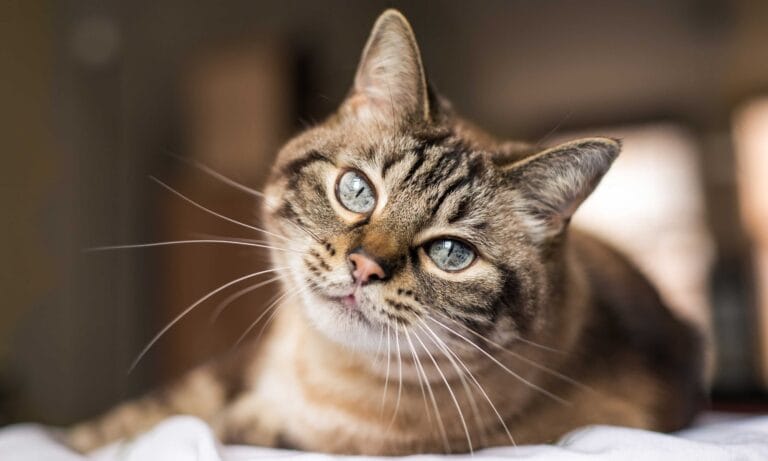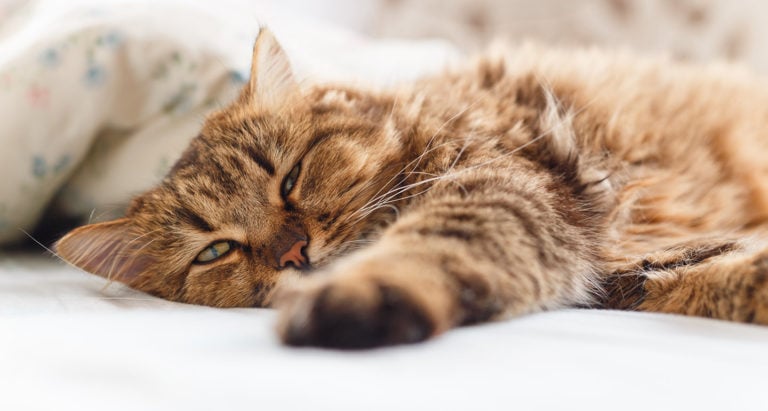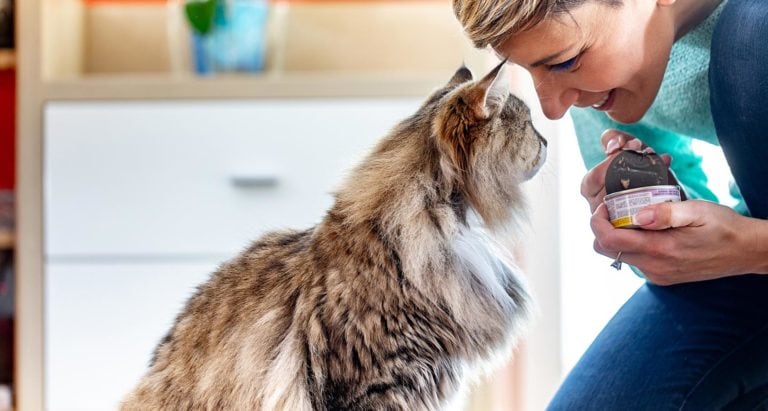I have a senior cat named Bob who is now almost 19 years old. Bob arrived in my life as a very small kitten. I was shopping in a pet store when a man walked in the door and handed me a screaming little ball of fur.
“I found him under a house at the construction site where I was working,” the man said. “Can you take him?”
Bob has been with me ever since.
Cats are territorial and take ownership of their space. A senior resident cat, like my Bob, has had a long time to claim his turf. His habits are established, and he is set in his ways. When I recently made the decision to add a younger cat to the family, I made sure to prepare for the big event.
Should you face a similar situation, you can take steps to minimize any squabbling when the new cat arrives.
Easy Does It
Older cats are a lot like senior humans and can be less tolerant and accepting when faced with changes in the environment. To reduce stress for your old cat, introductions should be gradual. Seniors may need extra assurance and comfort during the transition. Although not all cats will get along, many will benefit from companionship, and a newcomer may just add a spark to the environment.
Personality Plus
Every cat is an individual, and some animals, regardless of their species, immediately take to each other. This was the case when Bob met my dog, who now plays with him at every opportunity. But more often than not, and most likely with two felines, a proper introduction is on the agenda. This is especially true for your senior cat.
When choosing a new cat or kitten it helps to consider a personality type that will complement your older cat’s personality. Now in his golden years, my Bob is a laid-back lap cat, so I thought a good match for him might be a more playful, less sedentary cat. In my experience, a kitten poses the least threat to a senior cat.
I chose a particular orange tabby male kitten to add to the family. He was very friendly to me and tolerant of his pouncing siblings. I named him Juice. My introduction of Juice to my 19-year-old cat went surprisingly well.
Cat Introduction Guidelines
I’ve mentioned introductions a lot, so how should they be done?
Check The New Cat’s Health.
A visit to the veterinarian for nail trimming, vaccinations and assessing general health is always a prerequisite for every cat prior to an introduction.
Use The Power Of Your Cat’s Nose.
Scent swapping is a technique that can be used to help your senior cat get to know the newcomer before they even meet. Place a blanket with the new cat’s scent on it near your cat’s bed. You can also place toys or bedding that the new cat has used throughout the house for your cat to check out. If this isn’t possible beforehand, no worries — the technique can still be applied routinely as the cats get to know each other.
Keep Them Separated.
Ideally, place your new cat in a separate, closed-off bedroom for at least the first few days. Provide your new cat with a litter box, food, water, bedding and toys. It is best to immediately place the newcomer in the separate space and then direct your attention back to your senior. Spend most of your time with your older cat. She may go over to the door and hiss at the new intruder but just ignore this behavior and act like nothing has changed. Feed your senior cat treats near this bedroom door and praise her for any calm behavior. Do the same with the new cat in the bedroom. Talk in a comforting way to your senior cat, always reassuring her that she is still at the top of your list. Always remain calm and speak in a calm voice to your cats. It’s amazing how sensitive they are to your feelings, and your calmness will help them to be calm as well.
Trade Spaces.
Switch the cats’ places next by letting the new cat have the run of the house while you spend time with your senior cat in the bedroom. Let her check out things for a few hours and get used to the smells as you praise her and reinforce her calmly. When your senior cat is relaxed with the new scent she is experiencing, it’s time to switch the cats back to their original areas.
Be Casual During The First Meeting.
When it’s time for the two cats to meet and greet, calmly open the door to the bedroom and go about your business as if nothing has changed, while always keeping an eye on the cats and how they are behaving. A little hissing is OK at first, but be sure to run interference if they are screaming at each other or are out-and-out fighting. Too much quarreling means more separation time is needed.
Increasing The Cat Bond
Full acceptance may go quickly, or it may take a month or more for the cats to accept each other. To help them along with their newfound relationship and encourage bonding, teach the cats a few behaviors that are rewarded with special treats that they don’t receive in their regular diet. A good place to start is with “come.” Call them by name or say, “Here, kitty kitty.” My Bob already knows this, so he always comes running when a treat is involved. I tried this with the new kitten nearby, and he followed Bob to the treat. I gave them each a treat on the floor, far enough apart to prevent potential arguing. This creates a positive experience while the cats are in close proximity to one another.
In the winter months, one tool that can help cats be better bonders is a shared heat source. There are heating pads specifically designed for cats that can bring strangers closer together when seeking warmth or distract them from arguments when two pads are placed side by side. A heated cat bed will provide continuous heat at a safe, low level.
Signs Of Cat Stress
Often, especially when rescuing a new cat, there may not be the time or resources for a proper introduction. Maybe you don’t have a separate room for your cat, or your personal time is challenged by work obligations outside of the home. Any number of things can result in a hurried first encounter that could encourage unwanted stress and conflict. Sometimes the signs of stress are obvious — hissing, screaming, chasing and swatting are all conflict behaviors which, depending on their level of intensity, need to be addressed by separating the cats and giving them more time to adjust. In such cases, any time the cats spend together should be supervised and controlled. But there can be subtle signs of stress that may go unnoticed unless you watch for them:
- Is your senior cat sleeping in an unusual place?
- Is she moving from place to place and not getting enough rest?
- Are there changes in her use of the litter box?
Senior cats are prone to dehydration and, in claiming her territory, the new cat may be influencing your senior’s movements, keeping her away from the things she needs such as food, bedding, water and the litter box.
Minimizing Your Senior Cat’s Stress
Pay close attention to your senior cat and cater to her through this new period of adjustment. Direct most of your positive attention to your senior. Be sure to pet her and praise her often, washing your hands to remove the scent of the new cat beforehand. (It’s OK to continue with scent swapping and switching places).
If your older cat is young enough to still be playful, play with her first or create playtime together using a feather wand when the cats are in close proximity. Place water dishes throughout the house, and supervise feeding time to be sure your senior cat is eating enough. Feeding healthy treats by hand can remind your old cat that she is special. Also, it is up to you as the “top cat” to teach the new cat her place in the household. If she is too pushy or playful with your senior cat, redirect her play toward you and your feather wand. This has worked with young Juice, whose playtime is now directed toward me and his toys — and away from sleeping Bob.
Sometimes no matter how well you’ve prepared, things just won’t go as planned. A new younger cat or kitten may always play too rough with your old cat and be a constant source of stress. Also, every cat is an individual, capable of deciding on her own about whom to like or dislike. Usually, given time, two cats learn to accept each other, but once in a while two individuals never learn to get along.
If after months of concerted effort to create a friendship, the two cats insist on a relationship that includes consistent fighting, marking, harassment or otherwise unacceptable behavior, the cats may need to be permanently separated. Check with your veterinarian, who may recommend certain medications. If the situation is drastic, a new home for the new cat should be added to the list of considerations.
Patience Makes Purr-fect
Always be as patient as possible during the process of adding to your cat family. You may need to give the cats more time to adjust than you had planned on, so always try and see things from your cats’ point of view. Through your guidance, your senior cat and new feline family member can work toward their purr-fect relationship.
In 2008, Mollie Hogan formed her own company, Cat Business. Now as a cat behavior consultant she brings 25 years of animal training and her lifelong love of cats together to provide a unique and positive experience to both felines and their companions. Mollie has published numerous articles on animal behavior and her extensive knowledge of felines, in particular, allows her to assist others with their cat training needs.
Feature Image: Via JiriSebesta/iStock/Thinkstock
Share:









